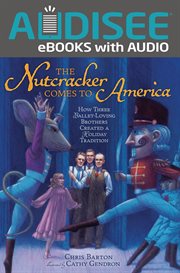Nonfiction
eBook
Details
PUBLISHED
Made available through hoopla
DESCRIPTION
1 online resource
ISBN/ISSN
LANGUAGE
NOTES
Audisee® eBooks with Audio combine professional narration and sentence highlighting for an engaging read aloud experience! Every December, The Nutcracker comes to life in theaters all across the United States. But how did this 19th-century Russian ballet become such a big part of the holidays in 21st-century America? Meet Willam, Harold, and Lew Christensen, three small-town Utah boys who caught the ballet bug from an uncle in the early 1900s. They performed alongside elephants and clowns on vaudeville, immersed themselves in the New York City dance scene, and even put on a ballet featuring gangsters at a gas station. Russian immigrants shared the story of The Nutcracker with them, and during World War II-on a shoestring budget and in need of a hit-they staged their own Christmastime production in San Francisco. It was America's first full-length version and the beginning of a delightful holiday tradition. Follow along and learn how The Nutcracker came to be performed all across the United States from these truly humble beginnings. "This well-researched history tells how three brothers from a small town in Utah came together to present the first full-length version of The Nutcracker in America. That performance on Christmas Eve, 1944, at the War Memorial Opera House in San Francisco started a holiday tradition that continues to this day in cities across the United States. Gendron's colorful illustrations capture the historical setting and the action and drama onstage and off. Back matter includes a time line with black-and-white photos, a summary of the story line, and suggestions for further reading. VERDICT: A terrific choice for fans of The Nutcracker and all things ballet."-starred, School Library Journal "William, Harold, and Lew Christensen grew up in a small Utah town in the early 1900s. When they discovered ballet, they worked hard at it and took their acrobatic dancing to Vaudeville, where they learned showmanship as well. Later William staged selections from The Nutcracker in Portland, while Harold and Lew danced in New York. In the 1940s, Lew served in World War II and William and Harold worked with the San Francisco Ballet, mounting the first full production of The Nutcracker in the U.S. Restaged by the three brothers in 1949, it became an annual holiday tradition. Best known for writing the Sibert Honor book The Day-Glo Brothers (2009), not to mention Shark vs. Train (2010), Barton offers a lively, colorful text and follows up with a very informative time line, illustrated with period photos, in the back matter. In her picture book debut, Gendron turns in a virtuoso performance. Her handsome illustrations capture the distinctive posture and poise of ballet dancers, while portraying even minor characters as individuals. Suffused with light and warmth, the varied, imaginative paintings include dynamic textured effects as well as an inventively used ribbon to tie pages together. Even readers familiar with The Nutcracker will probably learn a good deal from this engaging picture book. Bravo! Brava!"-starred, Booklist "Balancing evocative turns of phrase with a crisp, forthright narrative, Barton delivers an involving account of how watching The Nutcracker ballet, which originated in Russia, became an American holiday tradition. The movement was fueled by the Christensen brothers from Utah, who turned their passion for dance into careers in vaudeville and prestigious dance companies, before two of them choreographed and staged the first full-length American production of The Nutcracker in 1944. In her first picture book, Gendron uses pencil-and-oil art-strikingly textured with sweeping scratch-marks-to provide views from studio, audience, and stage wings, expertly capturing both the period setting and the graceful movements of the dancers. A detailed timeline and archival photos round out a fascinating bit of artistic investigation, one with year-round appeal."-starred,
Mode of access: World Wide Web







